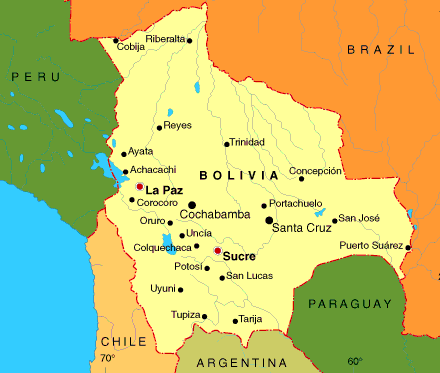High quality global journalism requires investment. Please share this article with others using the link below, do not cut & paste the article. See our Ts&Cs and Copyright Policy for more detail. Email ftsales.support@ft.com to buy additional rights. http://blogs.ft.com/beyond-brics/2012/10/22/bolivia-tests-market-with-500m-bond-issue/#ixzz2A4ibnuNm
 It took a while – over ninety years since the last one and almost nine months since it was first announced. But Bolivia finally took the plunge into the global credit market on Monday, with the launch of a $500m bond issue.
It took a while – over ninety years since the last one and almost nine months since it was first announced. But Bolivia finally took the plunge into the global credit market on Monday, with the launch of a $500m bond issue.
The 10-year dollar-issue, Bolivia’s first overseas offering since the 1920s, was priced at a 4.875 per cent yield, according to IFR.
Marcelo Urdininea, head of asset management at Banco Mercantil Santa Cruz in La Paz, said he expected demand for the bonds to outstrip supply by at least $250m.
“Bolivia’s numbers are solid, so there is a good expectation in the market for this paper,” he told beyondbrics.
That view was echoed by Bolivia’s leftist finance minister, Luis Arce, who told beyondbrics in late August: “We are sure we are going to do well in the markets, we have enough backing to welcome foreign investment. We want to position the country, there are several reasons why Bolivia should be in the international financial markets.”
Thanks in part to Arce’s prudent economic policies and thanks in part to high commodity prices, Bolivia’s economy has nearly tripled in size from $9bn in 2005 to $24bn this year. The Bolivian finance ministry is expecting the country to grow 5.5 per cent this year.
The country’s financial position has also been bolstered by its foreign reserves which is projected to hit $14bn in 2012 (compared to $1.7bn in 2005). Public debt stand at just 31 per cent of GDP.
As S&P noted in its review of Bolivia’s proposed bond issue last week:
Years of current account surpluses have led to a sharp build-up in Bolivia’s international reserves. This provides the country with an important buffer against potential external economic shocks, especially given its high dependence on natural gas and mining exports. Bolivia’s international reserves cover more than 11 months of current account payments, more than 100% of its financial sector’s total deposits, and 50% of its GDP. However, even if the government’s proposal to use up to $1 billion of the international reserves for infrastructure projects materializes, the country’s external indicators would remain one of the strongest among the sovereigns rated in the ‘BB’ category.
But not everything in the garden is rosy however. President Evo Morales’ penchant for nationalisations in sectors from electricity to mining and telecommunications has unnerved investors.
Arce argued that these re-nationalisations are part of the government’s redistributive policies that have helped lift about 4m people out of extreme poverty.
“The issuance of bonds is to help accelerate what we are already doing,” he said. “Today we are showing the world that we have the ability. And the great merit is that we are doing all of this on our own without anyone’s help.”
Caveat emptor, though, according to Gonzalo Chávez, a Harvard-educated financial economist based in La Paz, as he wrote in his blog over the weekend:
Posted By: Eunice NOf course reasons are not financial, but a combination of flagging investor’s radars and the quest of approval of the economic policies … from the side of the capitalist markets so criticized in the [government’s] discourses … We are now credit subjects leaving aside the occasional rhetoric burps against capitalism … It is very likely these Bolivian bonds will sell, the international financial market is full of liquidity. But only time will tell if what we attracted were speculative capital, or serious investments.
No comments:
Post a Comment